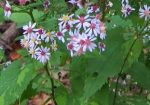 Also known as heart-leaved aster or blue wood aster, this clumping herbaceous perennial is a member of the aster family, Asteraceeae. that also includes sunflower, daisy, and lettuce. It is native to North America from Nova Scotia to Ontario, south to Georgia and Kansas where it grows in open woods, clearings, woodland edges, meadows, fields, and stream banks but can also be found in disturbed sites such as roadsides. Plants grow up to 2′-5- tall from a rhizomatous root system and has branched stems carrying five” long lanceolate lower leaves with coarsely toothed margins and heart-shaped bases. Upper leaves are smaller and ovate. In late summer and early autumn branched panicles of flowerheads appear. Each flowerhead is 1/2″-3/4″ across and is comprised of white to blue ray flowers surrounding a center of yellow disc flowers. The flowers are attractive to bees and butterflies. Although the plant is somewhat weedy it is good addition to butterfly garden, shade garden or native plant garden and is not appealing to deer and rabbits. The genus name, Symphyotrichum, comes from the Greek words symph meaning coming together and trich meaning hair and may refer to the anthers of the flowers. The specific epithet, cordifolium, comes from the Latin words cor, meaning heart, and folium meaning leaf and refers to the appearance of the large leaves.
Also known as heart-leaved aster or blue wood aster, this clumping herbaceous perennial is a member of the aster family, Asteraceeae. that also includes sunflower, daisy, and lettuce. It is native to North America from Nova Scotia to Ontario, south to Georgia and Kansas where it grows in open woods, clearings, woodland edges, meadows, fields, and stream banks but can also be found in disturbed sites such as roadsides. Plants grow up to 2′-5- tall from a rhizomatous root system and has branched stems carrying five” long lanceolate lower leaves with coarsely toothed margins and heart-shaped bases. Upper leaves are smaller and ovate. In late summer and early autumn branched panicles of flowerheads appear. Each flowerhead is 1/2″-3/4″ across and is comprised of white to blue ray flowers surrounding a center of yellow disc flowers. The flowers are attractive to bees and butterflies. Although the plant is somewhat weedy it is good addition to butterfly garden, shade garden or native plant garden and is not appealing to deer and rabbits. The genus name, Symphyotrichum, comes from the Greek words symph meaning coming together and trich meaning hair and may refer to the anthers of the flowers. The specific epithet, cordifolium, comes from the Latin words cor, meaning heart, and folium meaning leaf and refers to the appearance of the large leaves.
Type: Herbaceous perennial
Bloom: Branched panicles of white to blue flowerheads with yellow centers in late summer and early fall
Size:2′-5′ H 1.5′-2′
Light: Partial shade to full sun
Soil: Average, moist to dry, well-drained; drought tolerant
Hardiness: Zones 3-8
Care: Pinch back in spring to promote bushiness; remove spent flowerheads to prevent reseeding
Pests and Diseases: Aster wilt, rust, powdery mildew, leaf spot
Propagation: Seed, division
Companion Plants: Ferns, Eupatorium colestinum, Heliopsis helianthoides